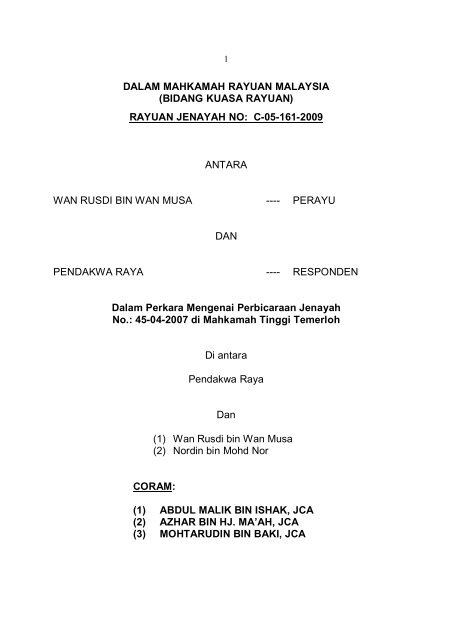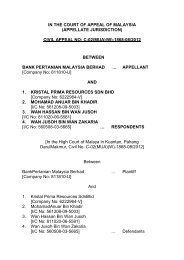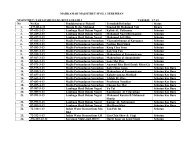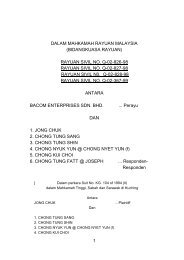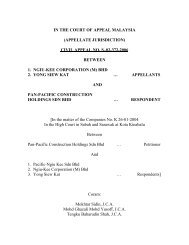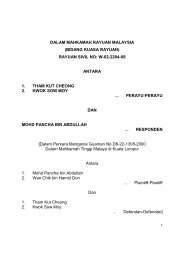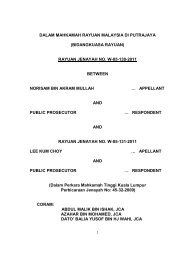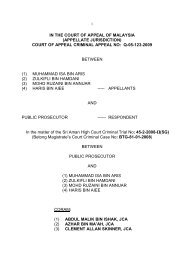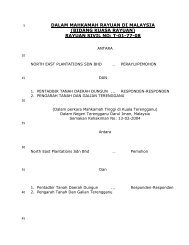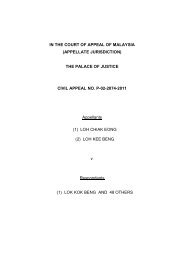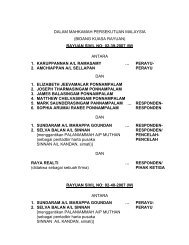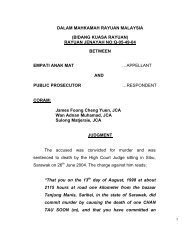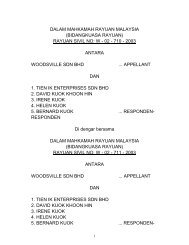rayuan jenayah no: c-05-161-2009 antara wan rusdi bin wan musa
rayuan jenayah no: c-05-161-2009 antara wan rusdi bin wan musa
rayuan jenayah no: c-05-161-2009 antara wan rusdi bin wan musa
Create successful ePaper yourself
Turn your PDF publications into a flip-book with our unique Google optimized e-Paper software.
1<br />
DALAM MAHKAMAH RAYUAN MALAYSIA<br />
(BIDANG KUASA RAYUAN)<br />
RAYUAN JENAYAH NO: C-<strong>05</strong>-<strong>161</strong>-<strong>2009</strong><br />
ANTARA<br />
WAN RUSDI BIN WAN MUSA ---- PERAYU<br />
DAN<br />
PENDAKWA RAYA ---- RESPONDEN<br />
Dalam Perkara Mengenai Perbicaraan Jenayah<br />
No.: 45-04-2007 di Mahkamah Tinggi Temerloh<br />
Di <strong>antara</strong><br />
Pendakwa Raya<br />
Dan<br />
(1) Wan Rusdi <strong>bin</strong> Wan Musa<br />
(2) Nordin <strong>bin</strong> Mohd Nor<br />
CORAM:<br />
(1) ABDUL MALIK BIN ISHAK, JCA<br />
(2) AZHAR BIN HJ. MA’AH, JCA<br />
(3) MOHTARUDIN BIN BAKI, JCA
Introduction<br />
2<br />
ABDUL MALIK BIN ISHAK, JCA<br />
DELIVERING THE JUDGMENT OF THE COURT<br />
[1] Initially, Wan Rusdi <strong>bin</strong> Wan Musa (the appellant herein) with<br />
Nordin <strong>bin</strong> Mohd Nor (“Nordin”) were charged for trafficking cannabis<br />
weighing 6,907 grammes on 15.7.2006 at about 8.30 p.m. at the Genting<br />
Sempah R & R, Bukit Tinggi in the district of Bentong, Pahang, an offence<br />
under section 39B(1)(c) of the Dangerous Drugs Act 1952 (“DDA”) and<br />
punishable under section 39B(2) of the DDA read with section 34 of the<br />
Penal Code. At the close of the prosecution’s case, Nordin was acquitted<br />
and discharged by the High Court. The prosecution did <strong>no</strong>t appeal against<br />
the decision of the High Court in acquitting and discharging Nordin at the<br />
close of the prosecution’s case.<br />
[2] The defence of the appellant was taken under oath and he too<br />
called a witness in support, namely, Wan Rosnaida <strong>bin</strong>ti Wan Musa (SD2).<br />
[3] At the end of the defence case, the appellant was convicted under<br />
section 39B(1)(c) of the DDA and sentenced to death under section 39B(2)<br />
of the DDA. Aggrieved, he <strong>no</strong>w appeals to this Court.
The factual matrix<br />
3<br />
[4] Within a short compass, the facts may be stated as follows.<br />
Detective sergeant Mohd Zulkifli <strong>bin</strong> Mat (SP5), a senior police officer<br />
attached to the Kuantan polis station, received an information from an<br />
informer about a drug trafficking activity that was carried out by a person<br />
named “DI”. On receipt of this crucial information, SP5 informed his<br />
superior officer by the name of ASP Xavier Soosainathan (SP3) about the<br />
matter. SP3 then directed SP5 to be an agent provocateur and to arrange a<br />
meeting with “DI” on the pretext of buying drugs.<br />
[5] On 14.7.2006, the informer informed SP5 that “DI” was willing to<br />
meet SP5 on 15.7.2006 at the Genting Sempah R & R at approximately<br />
7.00 p.m. SP5 relayed this information to SP3 and the latter called a<br />
meeting of his police personnel including SP5 and briefed them about an<br />
operation to trap and arrest “DI” – the target.<br />
[6] In that briefing, SP5 was directed by SP3 to meet the target<br />
through the informer. SP5 was also directed to purchase 7 kilogrammes of<br />
cannabis from the target on a one to one basis without the presence of the<br />
informer. And for this purpose, SP5 was given RM30,000.00 placed in a<br />
sling bag meant to purchase the cannabis. SP5 was also directed that as<br />
soon as SP5 had sight of the drugs, he was to give the following signal to
4<br />
the other police personnel: to drop a cigarette box and to pick it up. Upon<br />
seeing that signal, the police personnel will act to detain the target.<br />
[7] On 15.7.2006 at approximately 7.00 p.m., the informer met SP5<br />
at McDonald’s at Genting Sempah R & R. Not long thereafter, the target<br />
arrived. After the informer had introduced the target to SP5, the informer<br />
left the scene. The coast was clear, so to speak, for SP5 to deal direct with<br />
the target. In the High Court, the target was indentified by SP5 to be the<br />
appellant.<br />
[8] SP5 then discussed with the appellant in regard to the quantum<br />
and price of the drugs. After the appellant was shown the moneys in the<br />
sling bag, the appellant then brought SP5 to a red Perodua Kancil motor<br />
car bearing registration number WGG 9995 which was parked at the<br />
parking lot in front of the McDonald’s restaurant.<br />
[9] The Perodua Kancil motor car was <strong>no</strong>t locked and the appellant<br />
was seen by SP5 opening the front door of the said motor car on the<br />
driver’s side and pulling the lever in order to open the boot of the said<br />
motor car. From the boot, the appellant took out one black coloured plastic<br />
bag (exhibit “P18”) and placed it at the rear passenger’s seat. Again, the<br />
appellant took out from the boot of the said motor car, a box bearing the<br />
word “Greentek” (exhibit “P21”) and the appellant handed it to SP5.<br />
When asked by SP5 as to the contents of the box (exhibit “P21”), the
5<br />
appellant spontaneously replied “BARANG LA” and at the same time, the<br />
appellant took the box (exhibit “P21”) from SP5 and the appellant opened<br />
the top part of the said box and showed its contents to SP5. Having done<br />
that, the appellant then placed the said box together with its contents at the<br />
rear seat of the said motor car.<br />
[10] Satisfied that there were drugs inside the box (exhibit “P21”),<br />
SP5 pretended that he <strong>wan</strong>ted to pay and SP5 then gave the pre-arranged<br />
signal to arrest by dropping his cigarette box and picking it up again. SP5<br />
then took to his heels when SP3 and the police party rushed in to arrest the<br />
appellant. SP3 and the police party succeeded in arresting the appellant.<br />
SP3 examined the contents of the black coloured plastic bag (exhibit<br />
“P18”) and the box (exhibit “P21”) and found compressed dried vegetable<br />
matters suspected to be cannabis therein.<br />
[11] All the exhibits that were seized together with the appellant were<br />
then taken to the Bentong district police headquarters. The Perodua Kancil<br />
motor car had to be towed to the said police station because the keys were<br />
<strong>no</strong>t recovered from the appellant. At the said police station, SP3 marked all<br />
the exhibits and prepared the “Senarai bongkar” (exhibit “P15”) and<br />
lodged a police report vide Bukit Tinggi report number 490/2006 (exhibit<br />
“P16”). SP3 also handed all the exhibits that have been marked together
6<br />
with the appellant to the investigating officer Chief Inspector Pribhakaran<br />
(SP12).<br />
[12] After reading the police report (exhibit “P16”), SP12 proceeded,<br />
just like SP3, to mark all the exhibits also. However, SP12 did <strong>no</strong>t mark the<br />
Perodua Kancil motor car.<br />
[13] On 16.7.2006 at about 2.30 p.m., SP12 directed the police<br />
photographer Detective Corporal 131007 Rosli <strong>bin</strong> Zahari (SP2) to take<br />
seven photographs of the exhibits and these photographs were marked as<br />
exhibits (“P9A-G”). On the same day at about 4.25 p.m., SP12 directed<br />
SP2 to take five photographs of the Perodua Kancil motor car (exhibits<br />
(“P8A-E”).<br />
[14] On 17.7.2006 at about 9.45 p.m.,Nordin was arrested and he led<br />
the police to the recovery of the keys (exhibit “P14”) to the Perodua Kancil<br />
motor car at the public toilet of the Genting Sempah R & R.<br />
[15] In due course, the government chemist Abdul Rahim <strong>bin</strong> Shadan<br />
(SP4) analysed and confirmed that the packages contained dangerous<br />
drugs, to wit, 6,907 grammes of cannabis within the meaning of the DDA.<br />
[16] The prosecution also led evidence of the presence of DNA<br />
belonging to the appellant on at least two items that were found in the<br />
Perodua Kancil motor car. Again, the finger prints lifted from the Perodua
7<br />
Kancil motor car belonged to the appellant. Even the thumb print lifted on<br />
one of the packets belonged to the appellant.<br />
The defence<br />
[17] The appellant testified under oath along the following lines. One<br />
week before his arrest, he accompanied his sister (SD2) to register at UiTM<br />
Shah Alam on her final semester term. They travelled by bus from Kelantan<br />
and upon arrival at the bus stop at Kuala Lumpur, Nordin fetched them and<br />
brought them to Nordin’s house at Taman Mekar, Ampang. According to<br />
the appellant, he did <strong>no</strong>t bring anything from Kelantan. He said that he<br />
stayed at Nordin’s house for about a week. He said that the Perodua Kancil<br />
was used by Nordin and two others and he said that he did <strong>no</strong>t k<strong>no</strong>w who<br />
owned the said motor car.<br />
[18] On 15.7.2006 at about 7.00 p.m., the appellant drove the<br />
Perodua Kancil motor car with Nordin as a passenger and they stopped at<br />
Genting Sempah R & R. After the appellant locked the Perodua Kancil<br />
motor car, he handed the car keys (exhibit “P14”) to Nordin and they then<br />
parted company. The appellant went to purchase cigarettes and he also<br />
went to the McDonald’s restaurant to eat and there he met a friend by the<br />
name of “Mail” whom he knew for the last three years. He spoke to “Mail”<br />
for about five minutes and “Mail” then left him. He ate at the McDonald’s<br />
restaurant for about 50 minutes. Then he walked towards the Perodua
8<br />
Kancil motor car. He saw a man whom he did <strong>no</strong>t k<strong>no</strong>w standing near the<br />
Perodua Kancil motor car. While he was waiting for Nordin, he found that<br />
the left rear door of the said motor car was ajar and the window half<br />
opened. The appellant examined the said motor car and found a box<br />
located on the floor board of the left rear passenger’s seat. He lifted the<br />
box and placed it on the seat to enable him to gain access to the right rear<br />
door of the said motor car and to open the same. Having opened the right<br />
rear door of the said motor car, he got out and proceeded to open the<br />
driver’s side of the door and he pulled the lever in order to open the boot of<br />
the said motor car. From the boot, he took out one black coloured plastic<br />
bag (exhibit “P18”) and placed it on the seat of the front left passenger’s<br />
side. He then checked the spare tyre and found that it was intact.<br />
[19] The appellant testified further and he said that when he first<br />
drove the Perodua Kancil motor car, the black coloured plastic bag (exhibit<br />
“P18”) and the box bearing the word “Greentek” (exhibit “P21”) were <strong>no</strong>t<br />
inside the said motor car. He too testified that he did <strong>no</strong>t open exhibit<br />
“P18” and exhibit “P21” and he did <strong>no</strong>t k<strong>no</strong>w their contents. When he was<br />
about to close the boot of the said motor car, he was assaulted with a blunt<br />
object and he fell down and became unconscious. When he regained<br />
consciousness, he realised that he was arrested. And the police showed<br />
him the exhibits to the case only upon arrival at the police station. There he
9<br />
was forced to sign the “Senarai Bongkar” (exhibit “P15”). He denied<br />
meeting and discussing with SP5. He said that there was a<strong>no</strong>ther male<br />
person whom he did <strong>no</strong>t k<strong>no</strong>w who also got out from the McDonald’s<br />
restaurant as he did and proceeded towards the said motor car. He denied<br />
showing the contents of the box (exhibit “P21”) to SP5.<br />
[20] The evidence of SD2 went along the following lines. She is the<br />
sister of the appellant. She testified that in July 2006, the appellant<br />
accompanied her by bus to go to Kuala Lumpur from Kelantan because<br />
she <strong>wan</strong>ted to register for her final semester term at UiTM Shah Alam.<br />
According to her, the appellant did <strong>no</strong>t bring anything with him to Kuala<br />
Lumpur because he would be returning back to Kelantan. Upon arrival at<br />
the bus station in Kuala Lumpur at about 5.00 a.m., Nordin fetched both of<br />
them and brought them to Nordin’s house at Ra<strong>wan</strong>g. According to her,<br />
Nordin stayed in the house in Ra<strong>wan</strong>g with his friends. That morning, SD2<br />
went to the UiTM Shah Alam campus by herself. SD2 confirmed that she<br />
did <strong>no</strong>t k<strong>no</strong>w what transpired after that.<br />
Analysis<br />
[21] Questions of law were raised in the Amended Petition of Appeal<br />
and it was argued accordingly before us. It was argued that there were two<br />
charges against the appellant. The principal charge was under section<br />
39B(1)(a) of the DDA and punishable under section 39B(2) of the DDA
10<br />
read with section 34 of the Penal Code. The alternative charge was under<br />
section 39B(1)(c) of the DDA and punishable under section 39B(2) of the<br />
DDA read with section 34 of the Penal Code. Yet the learned Judicial<br />
Commissioner (“JC”) of the High Court in his written grounds of judgment<br />
laid emphasis on the alternative charge and found a prima facie case<br />
against the appellant under the alternative charge and after hearing the<br />
appellant’s defence convicted the appellant under the alternative charge<br />
and sentenced him to death. However, the consent of the Public<br />
Prosecutor under section 39B(3) of the DDA and the requisition under<br />
section 41A(1) of the DDA specified the offence to be under section<br />
39B(1)(a) of the DDA read with section 34 of the Penal Code and there was<br />
<strong>no</strong> mention of the punishable section under section 39B(2) of the DDA. For<br />
case of reference, the consent under section 39B(3) of the DDA and the<br />
requisition under section 41A(1) of the DDA are hereby reproduced (see<br />
page 9 of the appeal record at Jilid 1):<br />
“AKTA DADAH BERBAHAYA 1952<br />
(AKTA 234)<br />
IZIN DI BAWAH SEKSYEN 39B(3)<br />
REKUISISI DI BAWAH SEKSYEN 41A(1)<br />
PADA menjalankan kuasa-kuasa yang diberi kepada Pendakwa Raya<br />
oleh seksyen 39B(3) Akta Dadah Berbahaya 1952 dan terletakhak<br />
pada saya menurut seksyen 376(3) Kanun Tatacara Jenayah, saya<br />
ASLINA BINTI JONED Timbalan Pendakwa Raya, dengan ini memberi<br />
izin bagi pendakwaan:<br />
1. WAN RUSDI BIN WAN MUSA<br />
KP NO: 780213-03-5435; dan
2. NORDIN BIN MOHD NOOR<br />
KP NO: 680130-03-5247<br />
11<br />
lanjutan dari niat bersama memperedarkan dadah berbahaya, iaitu<br />
6907 gram Cananbis suatu kesalahan di bawah seksyen 39B(1)(a)<br />
Akta Dadah Berbahaya 1952 dibaca bersama seksyen 34 Kanun<br />
Keseksaan yang dikatakan telah dilakukan pada 15 Julai 2006, lebih<br />
kurang jam 8.30 malam di kawasan tempat letak kereta R & R,<br />
Genting Sempah, Bukit Tinggi, Bentong, Pahang.<br />
DAN, selanjutnya, pada menjalankan kuasa-kuasa yang diberi<br />
kepada saya di bawah seksyen 41A(1) Akta Dadah Berbahaya 1952,<br />
saya, dengan ini menghendaki supaya kes;<br />
1. WAN RUSDI BIN WAN MUSA<br />
KP NO: 780213-03-5435; dan<br />
2. NORDIN BIN MOHD NOOR<br />
KP NO: 680130-03-5247<br />
tersebut dibicarakan di Mahkamah Tinggi Malaya di Temerloh,<br />
Pahang.<br />
BERTARIKH pada 29 Disember 2006.<br />
Sgd. (Illegible)<br />
(ASLINA BINTI JONED)<br />
Timbalan Pendakwa Raya.”<br />
[22] It is a statutory requirement that the consent of the Public<br />
Prosecutor under section 39B(3) of the DDA is required before a<br />
prosecution under 39B(1)(a) or (b) or (c) of the DDA is instituted. Consent<br />
is said to be “an act of reason, accompanied with deliberation, the<br />
mind weighing, as in a balance, the good and evil on each side”<br />
(Abdul Hamid v. Public Prosecutor [1956] MLJ 231). The consent of the<br />
Public Prosecutor under section 39B(3) of the DDA and the requisition<br />
under section 41A(1) of the DDA specified the offence to be under section<br />
39B(1)(a) of the DDA and <strong>no</strong>t under section 39B(1)(c) of the DDA. Even the
12<br />
opening speech of the learned deputy public prosecutor pursuant to section<br />
179 of the Criminal Procedure Code (“CPC”) alluded to an offence under<br />
section 39B(1)(a) of the DDA. Can the consent under section 39B(3) of the<br />
DDA as reproduced earlier be said to have been given by way of a mature<br />
deliberation after weighing mentally the factual matrix of the case? We<br />
were invited to answer this crucial question in the negative bearing in mind<br />
that section 39B(1)(a) of the DDA makes reference to “traffic in a<br />
dangerous drug” while section 39B(1)(c) of the DDA alludes to the phrase<br />
to “do or offer to do an act preparatory to or for the purpose of<br />
trafficking in a dangerous drug”.<br />
[23] Although there is <strong>no</strong> requirement for consent under section<br />
39B(3) of the DDA to be given in writing, the existence of a written consent<br />
is useful in answering any subsequent challenge like the present case at<br />
hand. Now, since the consent here is in writing and signed, it is prima facie<br />
evidence of the existence of the relevant consent. However, it was argued<br />
that that consent applying Public Prosecutor v Lee Chwee Kiok [1979] 1<br />
LNS 96 made the trial a nullity (per Harun J (later SCJ)) bearing in mind<br />
that it specified an offence under section 39B(1)(a) of the DDA and <strong>no</strong>t<br />
section 39B(1)(c) of the DDA of which the appellant was convicted and<br />
sentenced to death. Harun J (later SCJ) in Public Prosecutor v Lee<br />
Chwee Kiok (supra) had this to say:
13<br />
“It will be observed that although the original and amended charges<br />
are two distinct offences, they are both created by the same section<br />
of the law viz. S. 39B(1) and both carry the same penalty. Both<br />
require the consent of the Public Prosecutor under s. 39B(3). The<br />
learned Deputy Public Prosecutor argued that the amendment was<br />
technical and as the Public Prosecutor had given his consent on the<br />
original charge he was at liberty to amend the charges in the manner<br />
he did. I do <strong>no</strong>t think so. It was held in Abdul Hamid v. Public<br />
Prosecutor [1956] 1 LNS 3 that a consent to prosecute ‘is an act of<br />
reason, accompanied with deliberation, the mind weighing, as in a<br />
balance, the good and evil on each side’. The Public Prosecutor has<br />
clearly exercised his mind in respect of the original charge when he<br />
gave his consent to prosecute some four months after the alleged<br />
offence. It was incumbent on him however to exercise the same<br />
degree of deliberation in respect of the amended charge. He has <strong>no</strong>t<br />
done so.”<br />
[24] In Tarmizi Yacob & A<strong>no</strong>r v. PP & A<strong>no</strong>ther Appeal [2010] 8<br />
CLJ 501, the Federal Court was concerned with the appellants in two<br />
appeals who were originally charged with an offence under section<br />
39B(1)(a) of the DDA read with section 34 of the Penal Code. At the end of<br />
the trial, both were however convicted and sentenced to death on the<br />
amended charge under section 39B(1)(c) of the DDA read with section 34<br />
of the Penal Code. The Federal Court agreed that consent to the amended<br />
charge preferred against the appellants would be superfluous as the<br />
prosecution was conducted by a deputy public prosecutor.<br />
[25] It was argued that the case of Tarmizi Yacob (supra) can be<br />
differentiated factually. There the trial proceeded for an offence under<br />
section 39B(1)(a) of the DDA and at the end of the trial, both the appellants<br />
were convicted and sentenced to death for an offence under section
14<br />
39B(1)(c) of the DDA read with section 34 of the Penal Code. Here, there<br />
were two charges. The first under section 39B(1)(a) of the DDA and there<br />
was consent for it. The second was an alternative charge under section<br />
39B(1)(c) of the DDA and the learned JC in his judgment alluded to the<br />
offence under section 39B(1)(c) of the DDA where there was <strong>no</strong> consent<br />
and at the end of the trial convicted the appellant under section 39B(1)(c) of<br />
the DDA read with section 34 of the Penal Code.<br />
[26] Before us, it was stre<strong>no</strong>usly argued that there was a miscarriage<br />
of justice when the consent in the present appeal was in regard to section<br />
39B(1)(a) of the DDA right from the start <strong>no</strong>twithstanding that there was an<br />
alternative charge under section 39B(1)(c) of the DDA.<br />
[27] The proviso to section 60(1) of the Courts of Judicature Act 1964<br />
carries the expression “miscarriage of justice”. The full text of the proviso<br />
reads as follows:<br />
“Provided that the Court of Appeal may, <strong>no</strong>twithstanding that it is of<br />
opinion that the point raised in the appeal might be decided in favour<br />
of the appellant, dismiss the appeal if it considers that <strong>no</strong> substantial<br />
miscarriage of justice has occurred.”<br />
[28] And the proviso to section 60(1) of the Courts of Judicature Act<br />
1964 is similar to the proviso of section 6(1) of the New South Wales<br />
Criminal Appeal Act 1912 and, in this context, it is germane to refer to the<br />
passage of Fullagar J in Mraz v The Queen [1955] 93 CLR 493 at page
15<br />
514 where his Lordship had this to say about the phrase “miscarriage of<br />
justice”:<br />
“It is very well established that the proviso to section 6(1) does <strong>no</strong>t<br />
mean that a convicted person, on an appeal under the Act, must<br />
show that he ought <strong>no</strong>t to have been convicted of anything. It ought<br />
to be read, and it has in fact always been read, in the light of the long<br />
tradition of the English criminal law that every accused person is<br />
entitled to a trial in which the relevant law is correctly explained to<br />
the jury and the rules of procedure and evidence are strictly<br />
followed. If there is any failure in any of these respects, and the<br />
appellant may thereby have lost a chance which was fairly open to<br />
him of being acquitted, there is, in the eye of the law, a miscarriage<br />
of justice. Justice has miscarried in such cases, because the<br />
appellant has <strong>no</strong>t had what the law says that he shall have, and<br />
justice is justice according to law. It is for the Crown to make it clear<br />
that there is <strong>no</strong> real possibility that justice has miscarried.”<br />
[29] Since “every accused person is entitled to a trial in which<br />
the relevant law is correctly explained to the jury and the rules of<br />
procedure and evidence are strictly followed”, can it be argued that the<br />
appellant has lost the chance to be acquitted by the High Court when the<br />
consent under section 39B(3) of the DDA that was issued for an offence<br />
under section 39B(1)(a) of the DDA was used for an offence under section<br />
39B(1)(c) of the DDA? By virtue of the doctrine of stare decisis, we are<br />
bound by the decision of the Federal Court in Tarmizi Yacob (supra) and,<br />
consequently, the answer to the question posed would be in the negative. It<br />
must be recalled that before the High Court, the prosecution was<br />
conducted by a deputy public prosecutor and the consent too was signed<br />
and issued by a deputy public prosecutor acting pursuant to section 376(3)
16<br />
of the CPC. As such, <strong>no</strong> written consent of the Public Prosecutor is<br />
required for convicting the appellant for an offence under section 39B(1)(c)<br />
of the DDA for the simple reason that the consent of the Public Prosecutor<br />
is implicit (Lyn Hong Yap v. Public Prosecutor [1956] 22 MLJ 226, CA;<br />
Public Prosecutor v. Oie Hee Koi & Associated Appeals [1968] 1 MLJ<br />
148, PC; Perumal v. Public Prosecutor [1970] 2 MLJ 265, FC; Public<br />
Prosecutor v. Mohamed Halipah [1982] 1 MLJ 155, HC; Public<br />
Prosecutor v. Datuk Haji Dzulkifli [1982] 1 MLJ 340, HC; Public<br />
Prosecutor v Lim Boon Hock & Ors [1985] 2 MLJ 219, HC; and Garmaz<br />
s/o Pakhar & A<strong>no</strong>r v Public Prosecutor [1995] 3 SLR 701, HC<br />
Singapore).<br />
[30] But the evidence adduced by the prosecution is far from<br />
satisfactory. There was <strong>no</strong> evidence as to who parked the Perodua Kancil<br />
motor car at the place mentioned in the charge. Neither was there evidence<br />
as to who put the drugs in the said motor car. The said motor car was<br />
unlocked at the material time. And the keys were <strong>no</strong>t found inside the said<br />
motor car. The evidence showed that the said motor car had to be towed to<br />
the Bentong district police headquarters. And it was Nordin who led the<br />
police to the recovery of the keys (exhibit “P14”) at the public toilet of the<br />
Genting Sempah R & R.
17<br />
[31] It was argued that there was <strong>no</strong> credible evidence linking the<br />
appellant to the drugs that were found in the said motor car. The appellant<br />
had <strong>no</strong> exclusive possession of the drugs in the said motor car bearing in<br />
mind that the registered owner of the said motor car was <strong>no</strong>t the appellant<br />
but rather one person by the name of Zahariman <strong>bin</strong> Alias (“Zahariman”).<br />
Exclusivity of possession is the hallmark to attract criminal liability for an<br />
offence of possession (Pendakwa Raya v Chan Peng Fatt [2000] 2 AMR<br />
14<strong>05</strong>; Public Prosecutor v Nordin A<strong>wan</strong>g [2001] 1 AMR 855; Pendakwa<br />
Raya v A Rashid <strong>bin</strong> Ismail [2001] 1 AMR 1149; PP v. Ong Cheng<br />
Heong [1998] 4 CLJ 209; PP v. Ibrahim Mahmud [2001] 3 CLJ 284;<br />
Pendakwa Raya v Nik Ahmad Aman <strong>bin</strong> Nik Mansor [2002] 2 AMR<br />
2515; Public Prosecutor v Kalaiselvan [2001] 4 AMR 3973; Public<br />
Prosecutor v Mohd Zambri <strong>bin</strong> Mohd Zelah [20<strong>05</strong>] 2 AMR 23; Public<br />
Prosecutor v. Rosyatimah bte Neza & A<strong>no</strong>r [1989] 1 MLJ 360; Public<br />
Prosecutor v Md Alim <strong>bin</strong> Samad [1998] 1 MLJ 260; and Tan Thong Jin<br />
v Pendakwa Raya [2002] 3 AMR 2982, CA). Here, the prosecution did <strong>no</strong>t<br />
lead evidence to show that it was the appellant who drove the said motor<br />
car to the Genting Sempah R & R on the date of the offence. But, in his<br />
defence, the appellant admitted driving the said motor car to the Genting<br />
Sempah R & R with Nordin as a passenger and parked the said motor car<br />
there. After having locked the said motor car, the appellant then handed the
18<br />
car keys (exhibit “P14”) to Nordin. But the appellant disassociated himself<br />
from the drugs found in the said motor car entirely.<br />
[32] Exclusivity of possession is required to sustain a conviction<br />
either for the offence of possession or trafficking of the dangerous drugs<br />
under the DDA. It is the duty of the prosecution to discharge this onerous<br />
burden. It is <strong>no</strong>t the duty of the defence to supplement the case for the<br />
prosecution (Abdullah Zawawi v. Public Prosecutor [1985] 2 MLJ 16,<br />
SC).<br />
[33] Now, the failure of the prosecution to call Zahariman as the<br />
registered owner of the said motor car invariably leads to a number of<br />
inferences – one of which must be construed in favour of the appellant.<br />
Spencer Wilkinson J in Tai Chai Keh v. Public Prosecutor [1948-1949]<br />
MLJ Supp 1<strong>05</strong> aptly said at page 108 of the report:<br />
“Where there is more than one inference which can reasonably be<br />
drawn from a set of facts in a criminal case, we are of opinion that<br />
the inference most favourable to the accused should be adopted.”<br />
[34] In the absence of Zahariman, we can<strong>no</strong>t rule out the possibility<br />
that the drugs were put inside the said motor car by Zahariman bearing in<br />
mind that the said motor car was unlocked when the appellant opened it in<br />
the presence of SP5. In his testimony, SP5 confirmed that the said motor<br />
car was unlocked (see page 89 of the appeal record at Jilid 1):<br />
“Sebaik sahaja sampai dekat kereta Kancil warna merah <strong>no</strong>mbor<br />
pendaftaran WGG 9995, ‘Di’ (referring to the appellant) telah
19<br />
membuka pintu kanan hadapan yang tidak berkunci dan menaikkan<br />
boot bahagian belakang.”<br />
[35] According to SP12, he met Zahariman after SP6 recorded<br />
Zahariman’s statement under section 112 of the CPC (see the<br />
examination-in-chief of SP12 at page 160 of the appeal record at Jilid 1 at<br />
paragraph 20). But Zahariman was <strong>no</strong>t called by the prosecution <strong>no</strong>r was<br />
his statement recorded under section 112 of the CPC tendered as an<br />
exhibit. SP12 tried to trace Zahariman but was unsuccessful. No<br />
explanation was advanced as to why the section 112 statement of<br />
Zahariman was <strong>no</strong>t tendered. It was a material document that was <strong>no</strong>t<br />
tendered and we accordingly invoke section 114(g) of the Evidence Act<br />
1950. The attempts made to trace Zahariman were insufficient and<br />
unreasonable in the circumstances. At page 160 to <strong>161</strong> of the appeal<br />
record at Jilid 1, SP12 testifed about the attempts to trace Zahariman in this<br />
way:<br />
“Saya ada cuba mengesan Zahariman di alamat terakhir tetapi tidak<br />
dapat dikesan. Selepas terima pengesahan dari JPJ, tiada siasatan<br />
lain dijalankan.”<br />
[36] To say the least, it was a feeble attempt to trace Zahariman and<br />
that attracts the invocation of adverse inference under section 114(g) of the<br />
Evidence Act 1950 (Munusamy v. Public Prosecutor [1987] 1 MLJ 492,
20<br />
SC; Ti Chuee Hiang v Public Prosecutor [1995] 2 MLJ 433, SC; and<br />
Public Prosecutor v Mohd Fahmi <strong>bin</strong> Hamzah [2002] 6 MLJ 340).<br />
[37] The prosecution in Public Prosecutor v Nordin A<strong>wan</strong>g (supra)<br />
did <strong>no</strong>t call or offer one Mohd Yusoff who had custody of the van in which<br />
the drugs were found and the court invoked section 114(g) of the Evidence<br />
Act 1950 and held that there was a gap in the prosecution’s case. Here, the<br />
<strong>no</strong>n-calling of Zahariman as the registered owner of the Perodua Kancil<br />
motor car had created a gap in the prosecution’s case. It is our judgment<br />
that the appellant has been prejudiced or disadvantaged by the failure of<br />
the prosecution to call Zahariman – a material witness. In our judgment,<br />
the fair trial of the appellant has been compromised (R v Russell-Jones<br />
[1995] 3 All ER 239, CA).<br />
[38] We ack<strong>no</strong>wledge that there was evidence of a negotiated sale to<br />
show k<strong>no</strong>wledge of the drugs on the part of the appellant. We also<br />
ack<strong>no</strong>wledge that the appellant’s DNA presence was detected on at least<br />
two items found in the said motor car. We further ack<strong>no</strong>wledge that<br />
fingerprints lifted from the said motor car belonged to the appellant and that<br />
the appellant’s thumb print was also lifted on one of the packets. But all<br />
these showed possession of the drugs and <strong>no</strong>t trafficking in the said drugs<br />
as per the charge. The impediments as alluded to earlier impinged on the<br />
prosecution’s case and it had prejudiced or disadvantaged the appellant
21<br />
beyond redemption for the <strong>no</strong>n-calling of Zahariman as the prosecution’s<br />
witness and the <strong>no</strong>n-tendering of the 112 statement of Zahariman as an<br />
exhibit. These impediments have the effect of casting reasonable doubt on<br />
the element of custody and control of the Perodua Kancil motor car in<br />
which the drugs were found.<br />
[39] It is undeniable that the prosecution has the complete discretion<br />
to call any number of witnesses subject to the requirement that it has a duty<br />
to call all the necessary witnesses essential to the unfolding of the narrative<br />
of the prosecution’s case. In our judgment, Zahariman should have been<br />
called because he is the umblical cord to connect the drugs to the appellant<br />
and to close the gaps in the prosecution’s case (Ti Chuee Hiang v Public<br />
Prosecutor (supra)).<br />
[40] It is our judgment that there is <strong>no</strong> evidence to prove that the<br />
appellant was exclusively in custody and control of the Perodua Kancil<br />
motor car before his arrest. The said motor car was <strong>no</strong>t locked and anyone<br />
could have access to it. To compound the matter further, the statement of<br />
Zahariman recorded under section 112 of the CPC was <strong>no</strong>t tendered<br />
pursuant to section 32(1)(i) of the Evidence Act 1950 and such failure<br />
brings to the fore the question of who was in actual control of the said<br />
motor car prior to the arrest of the appellant. The prosecution failed to<br />
exclude the possibility that other persons may have had custody or control
22<br />
of the said motor car in which the drugs were found prior to the arrest of the<br />
appellant.<br />
[41] For these varied reasons, it is <strong>no</strong>t safe to convict the appellant<br />
on the charge of trafficking under section 39B(1)(c) of the DDA and<br />
punishable under section 39B(2) of the DDA read with section 34 of the<br />
Penal Code. Accordingly, we allowed the appellant’s appeal and set aside<br />
the conviction and sentence imposed by the High Court. We substituted the<br />
conviction to one of possession under section 6 of the DDA and punishable<br />
under section 39A(2) of the DDA. Since the appellant was found to be in<br />
possession of a large quantity of cannabis weighing 6,907 grammes, we<br />
sentenced the appellant to twenty (20) years imprisonment from the date of<br />
arrest (15.7.2006) plus the mandatory whipping of ten (10) strokes of the<br />
rattan.<br />
16.2.2012 Dato’ Abdul Malik <strong>bin</strong> Ishak<br />
Judge, Court of Appeal,<br />
Malaysia
Counsel<br />
(1) For the Appellant : Puan Wan Jawahir bte Harun<br />
Solicitor : Messrs Wan Jawahir & Co<br />
Advocates & Solicitors<br />
Kelantan<br />
(2) For the Respondent/Prosecution: Puan Munahyza bte Mustafa<br />
Deputy Public Prosecutor<br />
Attorney-General’s Chambers<br />
Putrajaya<br />
Cases referred to in this judgment:<br />
(1) Abdul Hamid v. Public Prosecutor [1956] MLJ 231.<br />
(2) Public Prosecutor v Lee Chwee Kiok [1979] 1 LNS 96.<br />
(3) Tarmizi Yacob & A<strong>no</strong>r v. PP & A<strong>no</strong>ther Appeal [2010] 8 CLJ 501,<br />
FC.<br />
23<br />
(4) Mraz v The Queen [1955] 93 CLR 493, 514.<br />
(5) Lyn Hong Yap v Public Prosecutor [1956] 22 MLJ 226, CA.<br />
(6) Public Prosecutor v. Oie Hee Koi & Associated Appeals [1968] 1<br />
MLJ 148, PC.<br />
(7) Perumal v Public Prosecutor [1970] 2 MLJ 265, FC.<br />
(8) Public Prosecutor v Mohamed Halipah [1982] 1 MLJ 155, HC.<br />
(9) Public Prosecutor v. Datuk Haji Dzulkifli [1982] 1 MLJ 340, HC.<br />
(10) Public Prosecutor v Lim Boon Hock & Ors [1985] 2 MLJ 219, HC.
24<br />
(11) Garmaz s/o Pakhar & A<strong>no</strong>r v Public Prosecutor [1995] 3 SLR 701,<br />
HC Singapore.<br />
(12) Pendakwa Raya v Chan Peng Fatt [2000] 2 AMR 14<strong>05</strong>.<br />
(13) Public Prosecutor v Nordin A<strong>wan</strong>g [2001] 1 AMR 855.<br />
(14) Pendakwa Raya v A Rashid <strong>bin</strong> Ismail [2001] 1 AMR 1149.<br />
(15) PP v. Ong Cheng Heong [1998] 4 CLJ 209.<br />
(16) PP v. Ibrahim Mahmud [2001] 3 CLJ 284.<br />
(17) Pendakwa Raya v Nik Ahmad Aman <strong>bin</strong> Nik Mansor [2002] 2 AMR<br />
2515.<br />
(18) Public Prosecutor v Kalaiselvan [2001] 4 AMR 3973.<br />
(19) Public Prosecutor v Mohd Zambri <strong>bin</strong> Mohd Zelah [20<strong>05</strong>] 2 AMR<br />
23.<br />
(20) Public Prosecutor v. Rosyatimah bte Neza & A<strong>no</strong>r [1989] 1 MLJ<br />
360.<br />
(21) Public Prosecutor v Md Alim <strong>bin</strong> Samad [1998] 1 MLJ 260.<br />
(22) Tan Thong Jin v Pendakwa Raya [2002] 3 AMR 2982.<br />
(23) Abdullah Zawawi v. Public Prosecutor [1985] 2 MLJ 16, SC.<br />
(24) Tai Chai Keh v. Public Prosecutor [1948-1949] MLJ Supp 1<strong>05</strong>.<br />
(25) Munusamy v. Public Prosecutor [1987] 1 MLJ 492, SC.<br />
(26) Ti Chuee Hiang v Public Prosecutor [1995] 2 MLJ 433, SC.<br />
(27) Public Prosecutor v Mohd Fahmi <strong>bin</strong> Hamzah [2002] 6 MLJ 340.<br />
(28) R v Russell-Jones [1995] 3 All ER 239, CA.


